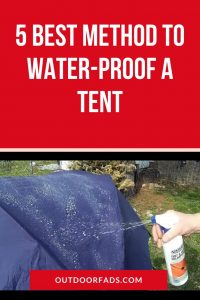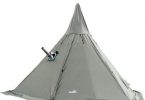We may receive commissions when you buy through the links on our site. Full Disclaimer.
If there is one thing that can take all the fun out of your camping trip faster than you can say ‘jumping jacks,’ it is a leaky tent.
Your camping tent is the most necessary gear on any camping trip, and that is why you need to take extra precautions and ensure that it is waterproof.
This article aims to teach you the best tent waterproofing methods, so that the next time you are on a camping trip, you can rest assured that you are covered, literally.
First Things First, Prevention
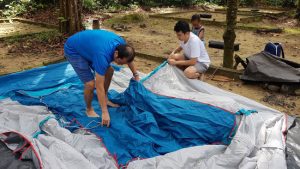
Nothing lasts forever, especially not the waterproofing coating of your tent. Besides, the manufacturers didn’t make it to last forever. How else would you buy another one?
One thing you need to realize is that labels can be very misleading, on purpose, and products can be falsely advertised. So what you think is a waterproof tent may only be water repellent or even, heavens forbid, water-resistant.
- To protect your tent, make sure always to pack the tent as carefully as you can.
- Keeping knives or any other sharp objects in the same place as your tent is begging for disaster.
- Keep your tent as clean as possible, do not leave food crumbs lying around, so that your tent does not become food for ants that will poke holes in it.
- Also, in the same way, you wouldn’t touch the inside of an umbrella when it is raining, accord your tent the same courtesy.
- Never wash the tent in a washing machine; the fabric will end up fraying and weakening, leading to leaks and sometimes tears.
All of these precautions are no guarantee that your tent will never need to be waterproofed; they just ensure that your tent does not need to be waterproofed ever so often.
When Should I Waterproof?
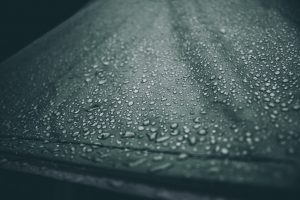
You should not just try to waterproof your tent on a whim, or you may end up doing more harm than good to that poor tent.
If your tent is relatively new, then there is probably no need to waterproof it, provided the manufacturer’s label can be trusted.
On the other hand, if your tent is aging but not entirely falling apart just yet, it may need to be reproofed. When then, should you waterproof your tent?
Put your tent’s waterproof capabilities to the test yourself.
How?
By spreading it out and taking a water spray to it. A tent in peak condition should have water beading on the surface, like pouring mercury on the windshield of a car.
If this isn’t happening and it seems as if the tent is being soaked, or water is leaking in, then it is time for waterproofing.
- Tents are always coated; that is how they stay waterproof. Constant use, elements, and age, though, do wear off the coating on the tent. When the layers are starting to come off, like flakes or powder, waterproofing should be done.
- When the tent is merely old, and there are no visible signs of leaking. If there’s a tiny nagging voice in your head telling you to waterproof your tent, you should listen. Better to be safe than sorry.
How to Waterproof a Tent
When the need finally arises for that old tent to be waterproofed, it is better to do it before the onset of any impending trips.
Else, you might still wake up all wet and soggy in your tent, and let me assure you; it is no fun.
The most vulnerable parts of a tent are the seams, the rainfly, the fabric, and the floor. If your tent is going to leak, it will be through one of those.
Seam Waterproofing
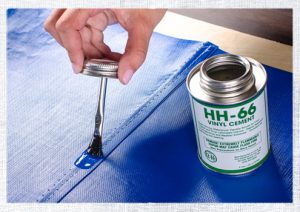
Tent seams are places where two or more pieces of tent fabric meet.
Seams are especially vulnerable to leaks because of the stitching that holds the fabric pieces together.
In some tents where the seams are not stitched, they are pressed together. Either the stitches or the pressing may become weak over time and result in your tent leaking.
The best way to check for leaks in seams is by checking the entire length of every seam. This can be quite the task as there are seams almost everywhere you look on the tent:
- along with the tent corners,
- the zip is sandwiched between two seams,
- windows and doors are demarcated with the aid of seams,
- and the floor is joined to the body with seams.
You’ve got your work cut-out waterproofing seams. To waterproof your tent seams:
- Make sure they are clean and dry. If the seams are dirty, mop them with a damp (not soaking wet) cloth and leave them to dry. Alternatively, you may use rubbing alcohol as it dries up faster than water.
- Apply your sealant along the seams. It would be of no consequence to apply the sealant to the outside or the inside or both. What matters is that you use enough sealant and have enough time to dry it properly before use.
- If there are tears along the seams, you need to stick a little tape on the inside and before spraying the outside with the sealant.
Rainfly Waterproofing
For tents with double walls, the rainfly is the outer part. It is there to protect the tent against the weather and other elements. A good rainfly should cover all the parts of the tent.
- Check the rainfly for leaks separately from the tent. That way, you are sure which one is leaking.
- Depending on whether you are using a dry application sealant or a wet application sealant, make sure that the rainfly is clean. The sealant will not stay on if your rainfly is dirty.
Fabric Waterproofing
This is the entirety of your tent. It is important to note here that tiny water droplets on the inside of the roof of your tent do not necessarily equate to leaking.
Sometimes, it is only condensation, moisture that comes from breathing and body heat. It is, therefore, best that you check for leaks on a sunny or warm day when you are less likely to mistaken condensation for leaking.
Purchase sealants that are appropriate to your tent fabric.
Natural fiber tents like jute will require different sealants than synthetic materials like nylon or polyester.
- Once you have your sealant, work around the tent section by section to ensure that all parts of the fabric are covered with the sealant.
- Apply the sealant using a brush or a spray can. Most sealants come in an aerosol form which you can apply directly by spraying.
- Use a piece of damp cloth to clean off any excess sealant as you work.
Tent Floor Waterproofing
The floor is essential when waterproofing your tent.
When the floor is leaky, your tent will be wet and uncomfortable even when it is not raining. Groundwater from vegetation and grasses will soak inside the tent.
Tent floor waterproofing involves:
- There are seams on the floor of your tent. Treat them as you would any other seam.
- Spray the inside of the floor with the same sealant that you used on the fabric. Wait for it to dry then apply the same on the outside of the floor for double protection.
- A double coat of sealant is always better than a single layer. When the first coat is almost dry, apply a second coat. Do not wait until the first coat is completely dry before applying the second.
- When waterproofing your tent floors, waterproof about two feet of fabric from the sides of your tent to the floor, for additional protection.
- Always use a tarp to protect the floor of your tent from piercing rocks. The tarp will also serve as a way of preventing damage to the floor of your tent.
Homemade Waterproofing Spray for a Tent
There are several types of waterproofing sprays or sealants, depending on the material of your tent.
If you have a canvas tent, there is a homemade waterproofing spray just for you. For that, you only require 2 ounces of rosin, 2 ounces of beeswax, and 2 cups of linseed oil.
Put the rosin and beeswax in the oven and heat to a temperature of about 250 degrees.
When they are all melted and thoroughly mixed, stir the solution in the linseed oil that is already boiled. Let cool, and you have your homemade waterproofing spray.
A Final Note
The best tent waterproofing methods involve an excellent blend of prevention, meticulousness, and proper care of the tent.
You should never trust the weather at the expense of your tent, believing that weather will be clement and thereby neglecting to waterproof your tent correctly.
In the same vein, you should never try to seal a leak on your tent with candle wax straight from a burning candle.
You may end up burning your tent to the ground. Cover your nose when applying sealants. Although most of them are described as having mild odors, the odors can be quite overwhelming when the sealant is wet.
With your now fully waterproof tent, you can go on to enjoy your next camping trip to the fullest.
